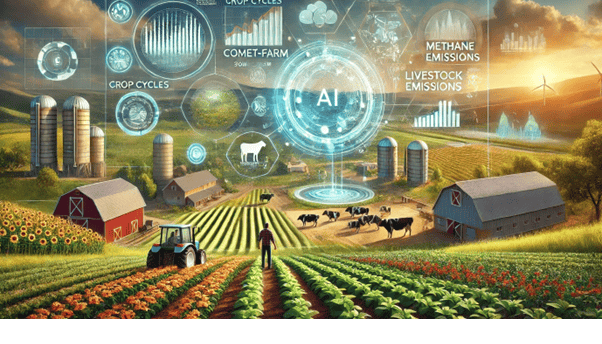The Impact of Artificial Intelligence on Precision Farming
Let’s explore the cutting-edge role of AI in precision farming! In 'The Impact of Artificial Intelligence’ on Precision Farming', we uncover how advanced tools like COMET-Farm and HOLOS are transforming crop management, livestock optimisation, and emission reduction. We also unveil how AI is innovating farming with data-driven insights to make it more sustainable. Join the journey toward a smarter, greener future for agriculture!
AGRICULTURE
Dr. Muhammad Shahzad, Assistant Professor, Department of Energy Systems Engineering, UAF. Dr. Muhammad Rizwan Tabassum, Assistant Professor, Department of Energy Systems Engineering, UAF. Dr. Muhammad Mubashar Omar, Assistant Professor, Department of Energy Systems Engineering, UAF.
12/26/20241 min read


Farm management is a big challenge especially when it involves the monitoring of soil, and livestock. The integration of Artificial Intelligence (AI) into farming is improving agricultural practices in many countries. Advanced farm management tools such as COMET-Farm and HOLOS models are extremely helpful to the farmers at crop selection and in resource management during the cropping period.
Improving Crop and Soil Management
Since AI is a data-driven field, it has been very effective in crop planning by analysing data related to weather patterns, soil conditions, and historical data to recommend optimal crop cycles and rotations. For instance, COMET-Farm uses random forest classifiers (supervised machine learning) and clustering techniques (unsupervised machine learning) to help selecting the appropriate fertilizer and the crop for maximum productivity. However, HOLOS model is used for perennial crops to increase productivity by monitoring soil texture and using irrigation data, while preserving soil health. Moreover, such models support decisions on intercropping, nutrient management, and minimizing soil toxicity.
Advancements in Livestock Management
Livestock management practices directly impact the environment and hence needs analysed critically. In animal agriculture, AI empowers management of livestock to balance productivity and environmental impact. COMET-Farm’s animal module analyses methane emissions and feed composition and recommend strategies to reduce carbon emissions and improve feed efficiency. By managing livestock weight and housing, it ensures both economic and ecological benefits.
Predictive Models for Farm Optimization
Generative Adversarial Networks (GANs) are used to simulate farm scenarios, and then select the optimised one achieving at least 15% reduction in energy consumption while increasing yield. GANs can predict crop for the season hence help in crop rotation improving strategies. It also provide efficient solutions for specific farming contexts. For instance, COMET-Farm has run over 3,600 crop scenarios, while HOLOS has analysed more than 1,200 runs for precision agriculture practices.
Overcoming Challenges
The big challenge in integrating AI in agriculture is the high costs of technology and limited access to data especially in rural areas. However, with increased farmer education and scalable solutions, these hurdles can be addressed effectively.
